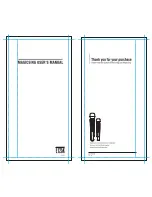
2.4 FLUSH MOUNTING OF THE
SPEAKER
Although the 1034BC may be used suc-
cessfully as a free standing speaker, flush
mounting is strongly recommended for
acoustical reasons. Flush mounting im-
proves the bass response and efficiency
and also enhances the midrange tran-
sient and frequency response.
The speaker has its acoustical axis mid-
way between the midrange and treble
drivers. This axis should be used as the
listening and measuring axis of the sys-
tem. (See Fig 1.)
The listening position should be between
2 ... 3.5m (6½ ... 11½') from the speakers.
The speaker should be aimed so that the
Note the following:
• A space 50…100 mm (2..4") wide can
be left around the speaker.
• Cover the space around the speaker
with a facing panel, this should be fixed to
the wall. Leave a gap of about 5..10 mm
(¼..½") between the speaker and the
panel. Fill this gap with a soft rubber
gasket to allow for possible cabinet move-
ment.
• Ensure that the speaker cables can
reach the rear of the speakers.
• If a light (e.g. wooden) wall is used, the
speaker cabinet should be mounted on
vibration isolators, with a resonant fre-
quency of around 2…8Hz, to prevent
vibrations from being transmitted to the
wall and impairing the low frequency
performance. The space around the
cabinet should be filled with absorbent
mineral wool or foam plastic. The walls
must be well braced.
• For a solid wall (e.g. concrete), the
speaker may be directly mounted to the
wall without vibration isolators. The space
around the cabinet should be filled with
mineral wool or sand bags.
Discontinuities in the speaker mounting
wall will cause diffraction, which leads to
inferior frequency response and stereo
imagery, so:
• Ensure that the cabinet is flush with the
surface of the wall.
• If a decorative cloth frame is used to
cover the wall, make sure that the edges
adjacent to the speaker are less than 20
mm (
3
/
4"
) deep. The cloth must be very
thin Tricot or acoustically transparent
material, otherwise the high frequency
response of the system will be adversely
affected. GENELEC approved cloth
grilles are available.
2.5 RECESS FOR LOUDSPEAKER
CONNECTORS
The speaker connector cable extends
100 mm (4") from the rear panel of the
loudspeaker. Therefore, a space at least
100 mm (4") deep must exist to allow for
the cable connectors behind the loud-
speaker. The dimensions of the recess
should be at least 100x150x120 mm
(4"x5
1
/
2
"x4
3
/
4
"), as shown in Fig. 5. Note
that the connectors are positioned off-
centre.
Ensure that there are no sharp bends on
the speaker cables and that they are not
subjected to pressure or caught between
objects. The cables are approximately 10
mm (
3
/
8
") thick.
vertical acoustical axis of the two speak-
ers meet midway between the standing
and seated listening position (1.4m - 4'7"
from the floor). This allows the correct
frequency response to be received by a
standing or seated person. The speakers
should not be mounted too high as this
increases the required vertical tilt of the
speaker and reduces the optimum listen-
ing area.
The ceiling, side walls and especially the
rear wall should be acoustically absor-
bent at low frequencies. The speaker
mounting wall should be acoustically hard
and therefore reflective. The speaker
mounting wall should be angled so that
the speakers are correctly aimed. Great
care should be taken over how the
speaker is mounted into the wall.
Fig 2. Speaker mounting.
Fig 2. Speaker mounting.
Fig 2. Speaker mounting.
Fig 2. Speaker mounting.
Fig 2. Speaker mounting.
Side view (top), Plan view (bottom).
Side view (top), Plan view (bottom).
Side view (top), Plan view (bottom).
Side view (top), Plan view (bottom).
Side view (top), Plan view (bottom).
Fig 3. Speaker mounting details.
Fig 3. Speaker mounting details.
Fig 3. Speaker mounting details.
Fig 3. Speaker mounting details.
Fig 3. Speaker mounting details.
Fig 4. Eliminating discontinuities.
Fig 4. Eliminating discontinuities.
Fig 4. Eliminating discontinuities.
Fig 4. Eliminating discontinuities.
Fig 4. Eliminating discontinuities.
Fig 5. Location and clearance require-
Fig 5. Location and clearance require-
Fig 5. Location and clearance require-
Fig 5. Location and clearance require-
Fig 5. Location and clearance require-
ment of loudspeaker connectors.
ment of loudspeaker connectors.
ment of loudspeaker connectors.
ment of loudspeaker connectors.
ment of loudspeaker connectors.
(Speaker rear view).
(Speaker rear view).
(Speaker rear view).
(Speaker rear view).
(Speaker rear view).
























